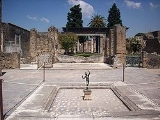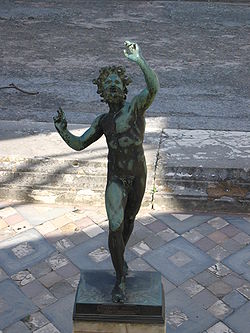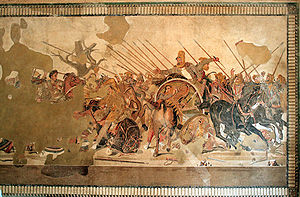
House of the Faun
Encyclopedia


Domus
In ancient Rome, the domus was the type of house occupied by the upper classes and some wealthy freedmen during the Republican and Imperial eras. They could be found in almost all the major cities throughout the Roman territories...
in Pompeii
Pompeii
The city of Pompeii is a partially buried Roman town-city near modern Naples in the Italian region of Campania, in the territory of the comune of Pompei. Along with Herculaneum, Pompeii was destroyed and completely buried during a long catastrophic eruption of the volcano Mount Vesuvius spanning...
, Italy, and housed many great pieces of art. It is one of the most luxurious aristocratic houses from the Roman republic
Roman Republic
The Roman Republic was the period of the ancient Roman civilization where the government operated as a republic. It began with the overthrow of the Roman monarchy, traditionally dated around 508 BC, and its replacement by a government headed by two consuls, elected annually by the citizens and...
, and reflects this period better than most archaeological evidence found even in Rome
Rome
Rome is the capital of Italy and the country's largest and most populated city and comune, with over 2.7 million residents in . The city is located in the central-western portion of the Italian Peninsula, on the Tiber River within the Lazio region of Italy.Rome's history spans two and a half...
itself.
History
The House of the Faun was built in the 2nd century BC, during the SamniteSamnium
Samnium is a Latin exonym for a region of south or south and central Italy in Roman times. The name survives in Italian today, but today's territory comprising it is only a small portion of what it once was. The populations of Samnium were called Samnites by the Romans...
period (200 - 80 BC). There is evidence, most notably in the eastern walls of the tetrastyle atrium
Atrium (architecture)
In modern architecture, an atrium is a large open space, often several stories high and having a glazed roof and/or large windows, often situated within a larger multistory building and often located immediately beyond the main entrance doors...
, that after the great earthquake in AD 62
62 Pompeii earthquake
The 62 Pompeii earthquake occurred on 5 February. It had an estimated magnitude of between 5 and 6 and a maximum intensity of XI or X on the Mercalli intensity scale. The towns of Pompeii and Herculaneum were severely damaged. The earthquake may have been a precursor to the eruption of Mount...
, the House of the Faun was rebuilt or repaired; yet, the building was only used as a house from the 2nd century BC until AD 79, ultimately rendered unusable by the eruption of Mount Vesuvius
Mount Vesuvius
Mount Vesuvius is a stratovolcano in the Gulf of Naples, Italy, about east of Naples and a short distance from the shore. It is the only volcano on the European mainland to have erupted within the last hundred years, although it is not currently erupting...
. Although the eruption was devastating, the layers of ash
Volcanic ash
Volcanic ash consists of small tephra, which are bits of pulverized rock and glass created by volcanic eruptions, less than in diameter. There are three mechanisms of volcanic ash formation: gas release under decompression causing magmatic eruptions; thermal contraction from chilling on contact...
covering the abandoned town preserved artworks, like the mosaic
Mosaic
Mosaic is the art of creating images with an assemblage of small pieces of colored glass, stone, or other materials. It may be a technique of decorative art, an aspect of interior decoration, or of cultural and spiritual significance as in a cathedral...
s of the House of the Faun, which would have otherwise been likely destroyed or decayed due to the passage of time.
The House of the Faun was named for the bronze statue of the dancing faun
Faun
The faun is a rustic forest god or place-spirit of Roman mythology often associated with Greek satyrs and the Greek god Pan.-Origins:...
located, originally, on the lip of the impluvium
Impluvium
The impluvium is the sunken part of the atrium in a Greek or Roman house . Designed to carry away the rainwater coming through the compluvium of the roof, it is usually made of marble and placed about 30 cm below the floor of the atrium.The name is also used for a type of dwelling typical of...
, a basin for catching rainwater; it has been moved to the center of the impluvium, as seen in the picture to the right. Faun
Faun
The faun is a rustic forest god or place-spirit of Roman mythology often associated with Greek satyrs and the Greek god Pan.-Origins:...
s are spirits of untamed woodland, which literate and Hellenized
Hellenization
Hellenization is a term used to describe the spread of ancient Greek culture, and, to a lesser extent, language. It is mainly used to describe the spread of Hellenistic civilization during the Hellenistic period following the campaigns of Alexander the Great of Macedon...
Romans often connected to Pan
Pan (mythology)
Pan , in Greek religion and mythology, is the god of the wild, shepherds and flocks, nature, of mountain wilds, hunting and rustic music, as well as the companion of the nymphs. His name originates within the Greek language, from the word paein , meaning "to pasture." He has the hindquarters, legs,...
and Greek satyr
Satyr
In Greek mythology, satyrs are a troop of male companions of Pan and Dionysus — "satyresses" were a late invention of poets — that roamed the woods and mountains. In myths they are often associated with pipe-playing....
s, or wild followers of the Greek god of wine and agriculture, Dionysus
Dionysus
Dionysus was the god of the grape harvest, winemaking and wine, of ritual madness and ecstasy in Greek mythology. His name in Linear B tablets shows he was worshipped from c. 1500—1100 BC by Mycenean Greeks: other traces of Dionysian-type cult have been found in ancient Minoan Crete...
. It is purely decorative sculpture of a high order: "the pose is light and graceful," Sir Kenneth Clark observed, the modeling well understood, the general sense of movement admirably sustained," though he missed in its suavity the stimulus of sharper contrasts to be found in Renaissance nudes.
Archaeologists discovered an inscription bearing the cognomen
Cognomen
The cognomen nōmen "name") was the third name of a citizen of Ancient Rome, under Roman naming conventions. The cognomen started as a nickname, but lost that purpose when it became hereditary. Hereditary cognomina were used to augment the second name in order to identify a particular branch within...
Saturninus, suggesting that the dwelling was owned by the important gens
Gens
In ancient Rome, a gens , plural gentes, referred to a family, consisting of all those individuals who shared the same nomen and claimed descent from a common ancestor. A branch of a gens was called a stirps . The gens was an important social structure at Rome and throughout Italy during the...
, or clan, Satria; a ring bearing the family name Cassius
Cassius (gens)
The gens Cassia was a Roman family of great antiquity. The gens was originally patrician, but all of the members who appear in later times were plebeians. The first of the Cassii to obtain the consulship was Spurius Cassius Viscellinus, in 502 BC. He was the proposer of the first agrarian law,...
was also found, indicating that someone of the Cassii family married into the gens Satria and lived in the House of the Faun.
Artworks

Alexander Mosaic
The Alexander Mosaic, dating from circa 100 BC, is a famous Roman floor mosaic originally from the House of the Faun in Pompeii. It depicts a battle between the armies of Alexander the Great and Darius III of Persia and measures 5.82 x 3.13m .-Battle:The mosaic illustrates a battle in which...
, depicting the Battle of Issus in 333 BC between Alexander the Great and Darius III of Persia
Darius III of Persia
Darius III , also known by his given name of Codomannus, was the last king of the Achaemenid Empire of Persia from 336 BC to 330 BC....
. This mosaic is inspired by or copied from a Greek painting finished in the late fourth century BC, probably by the artist Philoxenus of Eretria
Philoxenus of Eretria
For other uses, see PhiloxenusPhiloxenus of Eretria was a painter from Eretria, the disciple of Nicomachus of Thebes, whose speed in painting he imitated and even surpassed, having discovered some new and rapid methods of colouring Nevertheless, Pliny states that there was a picture of his which...
. Unlike most Pompeian pavements of the late second and early first centuries, this mosaic is made of tesserae
Tessellation
A tessellation or tiling of the plane is a pattern of plane figures that fills the plane with no overlaps and no gaps. One may also speak of tessellations of parts of the plane or of other surfaces. Generalizations to higher dimensions are also possible. Tessellations frequently appeared in the art...
, and not the more common opus signinum
Opus signinum
Opus signinum is a building material occasionally used in ancient Rome. It is made of tiles broken up into very small pieces, mixed with mortar, and then beaten down with a rammer...
, or other kinds of stone chips set in mortar.
The Alexander Mosaic is complemented by other floor mosaics with Nilotic
Nilotic
Nilotic people or Nilotes, in its contemporary usage, refers to some ethnic groups mainly in South Sudan, Uganda, Kenya, and northern Tanzania, who speak Nilotic languages, a large sub-group of the Nilo-Saharan languages...
scenes and theatrical masks. Other notable works of art from the House of Faun include an erotic Satyr and Nymph and the fish mosaic, a piece closely resembling other mosaics in Pompeii.
Architecture

Insulae
In Roman architecture, an insula was a kind of apartment building that housed most of the urban citizen population of ancient Rome, including ordinary people of lower- or middle-class status and all but the wealthiest from the upper-middle class...
. The house can be divided into five major parts: the Tuscan atrium, tetrastyle atrium, service rooms and corridors, first, or Ionic
Ionic order
The Ionic order forms one of the three orders or organizational systems of classical architecture, the other two canonic orders being the Doric and the Corinthian...
, peristyle
Peristyle
In Hellenistic Greek and Roman architecture a peristyle is a columned porch or open colonnade in a building surrounding a court that may contain an internal garden. Tetrastoon is another name for this feature...
, and second, or Doric
Doric order
The Doric order was one of the three orders or organizational systems of ancient Greek or classical architecture; the other two canonical orders were the Ionic and the Corinthian.-History:...
, peristyle, and their corresponding dependent rooms. Like many ancient Roman houses, the House of the Faun had taberna
Taberna
A taberna was a single room shop covered by a barrel vault within great indoor markets of ancient Rome. Each taberna had a window above it to let light into a wooden attic for storage and had a wide doorway....
e, or storefront shops, and a highly-sophisticated building plan, which details the many rooms. The entrance is decorated by the Latin
Latin
Latin is an Italic language originally spoken in Latium and Ancient Rome. It, along with most European languages, is a descendant of the ancient Proto-Indo-European language. Although it is considered a dead language, a number of scholars and members of the Christian clergy speak it fluently, and...
message “HAVE
Ave
Ave is a Latin word, used by the Romans as a salutation and greeting, meaning "hail". It is the singular imperative form of the verb avēre, which meant "to be well"; thus one could translate it literally as "be well" or "farewell"....
”, a greeting both for meeting and parting.
Like other wealthy aristocrats of the Roman Republic, the owners of the House of the Faun installed a private bath system
Ancient Roman bathing
Bathing played a major part in ancient Roman culture and society.Bathing was one of the most common daily activities in Roman culture, and was practiced across a wide variety of social classes. Though many contemporary cultures see bathing as a very private activity conducted in the home, bathing...
, or balneum
Balneum
Balneum is a genus of bush cricket in family Tettigoniidae subfamily Phaneropterinae....
, in the house. The bathing room was located in the domestic wing, which was to the right of the entrance, and along with the kitchen was heated by a large furnace. The servants’ quarters were dark and cramped, and there was not much furniture. The house features beautiful peristyle gardens, the second of which was created as a stage to host recitation
Recitation
A recitation is a presentation made by a student to demonstrate knowledge of a subject or to provide instruction to others. In some academic institutions the term is used for a presentation by a teaching assistant or instructor, under the guidance of a senior faculty member, that supplements...
s, mimes
Mime artist
A mime artist is someone who uses mime as a theatrical medium or as a performance art, involving miming, or the acting out a story through body motions, without use of speech. In earlier times, in English, such a performer was referred to as a mummer...
, and pantomime
Pantomime
Pantomime — not to be confused with a mime artist, a theatrical performer of mime—is a musical-comedy theatrical production traditionally found in the United Kingdom, Australia, New Zealand, Canada, Jamaica, South Africa, India, Ireland, Gibraltar and Malta, and is mostly performed during the...
s. Additionally, the house contained an entrance passage, a number of bedrooms (cubicula), dining rooms (triclinia
Triclinium
A triclinium is a formal dining room in a Roman building. The word is adopted from the Greek τρικλίνιον, triklinion, from τρι-, tri-, "three", and κλίνη, klinē, a sort of "couch" or rather chaise longue...
) for both the summer and winter, a reception room (oecus
Oecus
Oecus, the Latinized form of Gr. oikos, house, used by Vitruvius for the principal hall or salon in a Roman house, which was used occasionally as a triclinium for banquets....
), and an office (tablinum
Tablinum
In Roman architecture, a tablinum was a room generally situated on one side of the atrium and opposite to the entrance; it opened in the rear on to the peristyle, with either a large window or only an anteroom or curtain...
).
Remains

Naples National Archaeological Museum
The Naples National Archaeological Museum is a museum in Naples, southern Italy, at the northwest corner of the original Greek wall of the city of Neapolis. The museum contains a large collection of Roman artifacts from Pompeii, Stabiae and Herculaneum...
(Museo Archeologico Nazionale) in Naples
Naples
Naples is a city in Southern Italy, situated on the country's west coast by the Gulf of Naples. Lying between two notable volcanic regions, Mount Vesuvius and the Phlegraean Fields, it is the capital of the region of Campania and of the province of Naples...
, the most famous pieces, like the Dancing Faun and the Alexander Mosaic, have been recreated to give tourists a clearer picture of what the house was originally like. Pietro Giovanni Guzzo, one of Pompeii’s past archaeological superintendents, explained, “I want visitors to have the impression that they are entering the same luxurious house in which the ancient Pompeian owners lived before it was destroyed by the eruption of Mount Vesuvius in AD 79.”

